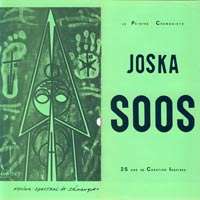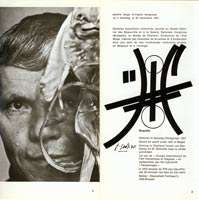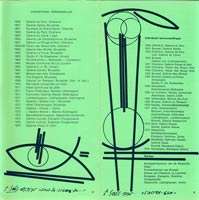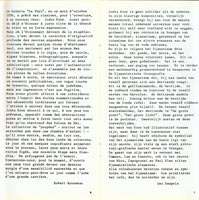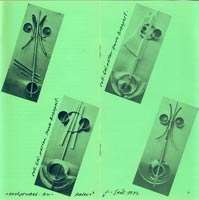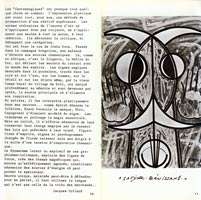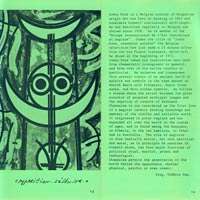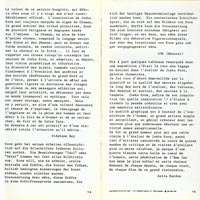|
back of the flyer:
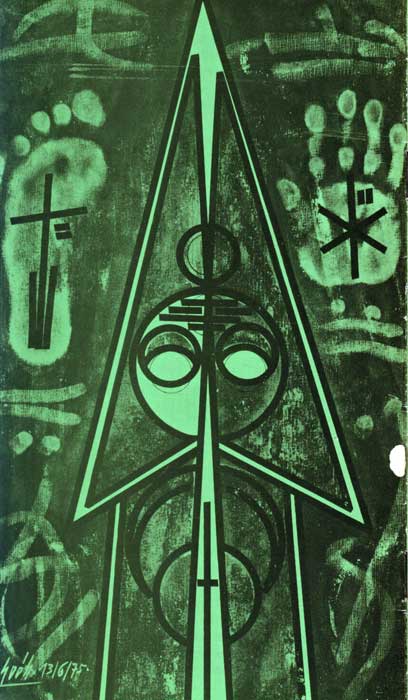
moine spectrale de sénanque
(spectral monk of ?)
|
front page:
The Shamanistic
Painter
Joska Soos
25 years
of inspired creation |
page2:

In this picture Joska is holding up a seadevil. It is a kind of fish
that once dried and flattened almost look human. |
page 3:
Hungarian-born painter born in Apostag, December 20,
1921.
Numerous group exhibitions, works in the National Museum of
Fine Arts and the Hungarian National Gallery (Budapest), at the Museum
of Charleroi, Collections of the Belgian State , Cabinet of Prints in
Brussels and Amsterdam as well as abroad.
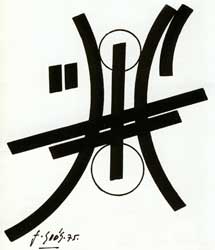
Born in Apostag (Hungary), 1921. Lives and works since 1947 in Belgium.
Received in Charleroi lessons from Ben
Genau and M. Delmotte but is
otherwise self-taught.
Member of Groupe International de I'Art
Fantastique et Magique - and contributor to the magazine FantasMagie".
In 1970, the RTB [this the French language Belgian television] made a
color film, 25 minutes long, about him and his work. Workshop: Maarshalk
Fochlaan 5, 1030 Brussel |
page 4:
Personal exhibitions
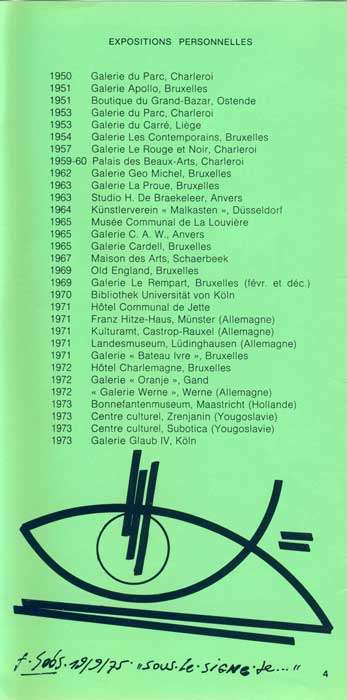
"Sous le signe Je..."
(under the sign Me...) |
page5:
Personal exhibitions
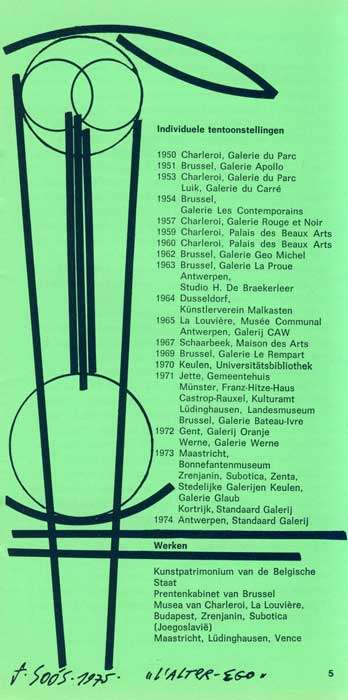
"The Alter Ego" |
page 6:
The gallery "The Park", in October 1950, has
opened its doors for a newcomer: Joska Soos . One can guarantee oneself
of his character and his strong expression.
But amazement becomes
astonishment before the originality of the deep character of exhibited
works. We are faced with something absolutely new, not only by means of
lines drawn with a ruler , arcs, weird signs, stenographs , which we
would not be far from attributing a cabalistic meaning - but also by the
authenticity of inspiration: we do not gather from all parts such
evocations.
From time to time, the viewer believes to have discovered
a pre-Columbian artifact, a vague touch of Byzantine , some whiff
of Judaism, but his impression is only fugitive. Rather we are dealing
with a coincidence between the spirit of the above schools and domestic
requirements that force the artist to work in a specific way. Joska Soos
leads to what our unprejudiced eyes, appears as pure abstractions and
manages to keep it all as well as a veteran of Shows in May. The
collection of "dolls" - especially are not for a child's room. It shows
us seemingly, his innate gifts as a painter. The day these disturbing
masks animate under the brush, their dead eyes and frozen rictus, a new
step will be taken. Do not prejudge the future. Suffice it for now to
open our eyes wide for the coming of heightened sensitivity drawings and
maybe one day we salute this as the dawn of a great career.
Robert Rousseau
|
page 7:
Joska Soos is not a painter like the others . In
his colorful compositions, formally justified, he brings to most people
a totally unknown universe. As he aptly managed to say, he tries to
bring the heraldry, shamanism, based on totemism that finally also
formed the basis of the old emblems.
Now, according to the Shamanism
there are three unities: the good, the beautiful and the true. These all
belong together. This is not a doctrine , not a religion: it is a
technique , an attempt to know. This is also witnessed in the
shamanistic iconography.
Now in shamanism, when there is a series of
twelve people. a thirteenth person will show up: this is the
illuminated, the liberated one. In ancient times we find this with the
twelve labors of Herculus : the thirteenth set him free. King Arthur was
liberated one at the round table: there were twelve knights and himself.
We know twelve constellations, the thirteenth is "the great gate", "the
light". This large gate is the pole star. Mentally we should transcend
this.
The work of Soos could be illustrative, but the artist is not
caught up in it: he tells us that the symbolism of shamanism is the
basis of his work, namely bringing forth his vision in a strong
pictorial - graphical way. The spirit of his work is related to Tamayo,
Lam and Camacho, also in the works of Miro, Capo Grossi and Paul Klee
there are shamanic elements.
All folk arts include signs and symbols
of shamanism : the more primitive the people, the purer they are.
Geo
Sempels
|
page8:
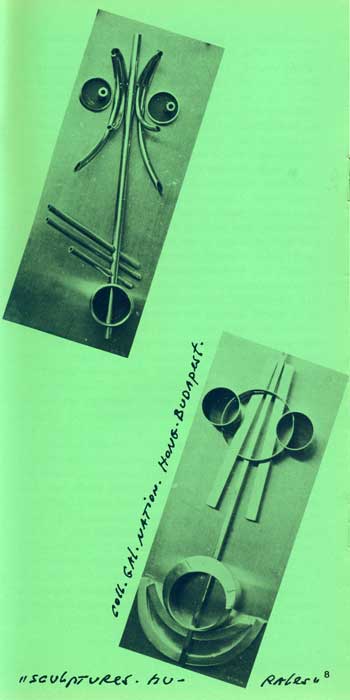 |
page 9:
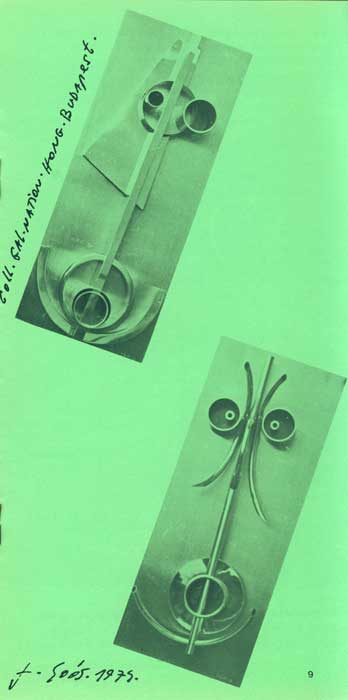 |
page 10:
The "fantasmagiques" almost all have something
in common: visual expression is primarily, a method of exploration of a
higher reality. Ordinary standards of the artwork does not always apply,
therefore, it does not always apply in their creations. They confuse
criticism and escape the categories.
Such is the case of Joska Soos.
He was brought up in the Hungarian countryside, his childhood was
steeped in shamanic sources. Here, as in Africa, the blacksmith, the
Master of Iron, is the one who holds the secrets of making contact with
the spirit world. Magical signs drawn in the dust, traced in the air and
on the water, on men, on animals and equally on objects, by the old
Tamas Bacsi from the village of Solt, left deep markings on his memory
and them afterwards became the main source of his inspiration.
As an
artist, he interprets them in a fluent way in his works ... as Bartok
did with folklore, as Ensor pushes beyond the mask, as Miro and
Capogrossi soar beyond the signs. Lam transposes and extends ancient
magic. But being an insider, he nevertheless seeks to retain their
magic, supported by the observance of the laws that underlie their
tracing. Depictions of spirits , signs and psychograms which are charged
with energy are born under his fingers after a pessure of shamanic
inspiration.
The latent or explosive dynamism of these graphics and
talismans, exploits the lines of force, and creates magnetic fields,
which are yet aesthetically arranged, however, are sources of energy
that can draw in the viewer.
Unique work, perhaps difficult to
justify: if you want to speak about it, one needs to use a language that
is not common.
Jacques Collard
|
page 11:
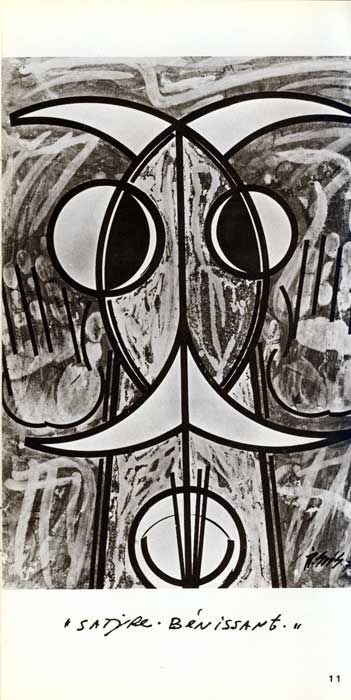
"satyre bénissant"
(benevolent satyr) |
page12:
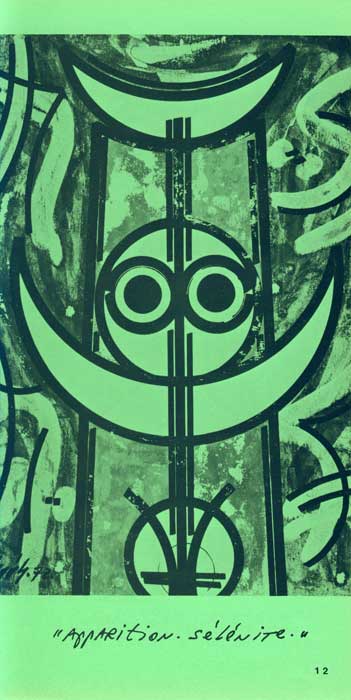
"apparition sélénite" |
page 13:
Joska Soos is a Belgian painter of Hungarian
origin who was born at Apostag in 1921 and considers himself
continuously self-taught. He has exhibited regularly in Belgium and
abroad since 1950. He is member of the "Groupe international de L'Art
fantastique et magique". Under the title of "Joska Soos, chamanist
painter" the Belgian television has just made a 25 minute colour film
for its French listeners, which will be shown at the beginning of 1971.
Joska Soos takes his inspiration very much from shamanistic iconography
in general, and from that of his native country in particular. He
animates and transposes this archaic vision of an ancient world of
spirits and symbols in the same manner as Bartok deals with folk music,
Ensor forms masks, and Miro evokes symbols. He follows a stream where
the artist becomes the great evocator of animated archetypal images and
the magician of caverns of darkness. Shamanism is now considered as the
first form of a magical technical showing knowledge and mastery of the
visible and invisible world. It originated in polar regions and has
expanded all over the world in the course of ages, and is found among
the Eskimos, in Siberia, in the two Americas, in Tibet and in
Australia. The role of magician is thus basically social, but also
spiritual and moral, as in principle he reunites in himself alone, the
four major functions of political chief, warrior, priest and
technologist.
Shamanism permits the penetration of the world behind
the appearance, whether physical, psychic or even cosmic.
Prog. Théatre
Exp.
|
page 14:
The talent of the Hungarian painter, who started
working with us twenty years ago is well developed. The
inspiration Joska Soos is always marked with elements of shamanism, the
great wizard of primitive tribes who is endowed with religious and
magical powers based on ecstatic experiences. The Shaman, in addition to
many other things , has the secret language of gods and demons, and can
take on the form of an animal, become invisible , control heat and cold
... We must remember these things when contemplating the works of Joska
Soos, and admit at the outset of it their forbidden and prophetic
visions. The diversity of subjects, always returns to the evocation of
ancestors and tenebrous entities in the far north or Asia, and allows
the artist to mix the Ligurian or Saracen warriors faces of clowns or
selenite messengers that, despite timeliness, do not clash in this
mythical and timeless world. All this is pretty wild, pretty grim. But
we perceive, in addition to a moving and tenacious will to express
themselves, the testimony of the anguish and pain of men and their
desire to both escape and hide, to flee and face things.
We give this
primitive art and complete sincerity the attention it deserves.
Stéphane Rey
Soos is evident in his work on the image
writings from earlier cultures. The terms "idol" or "mind" occur in
almost all image titles. Soos wants, it seems, to make visible ancient
impulses and forces that lie behind the joyful expressions of art.
Prerequisite for this would be that these forces are being put into a
written language, in accordance with our present state of
consciousness...
|
page 15:
...The esoteric depictions as it expresses itself in the pictures of
Soos could be the basis for a wider expression; unless one would see
these pictures as decorative figures, but the intentions of Soos are
quite contrary.
GVK (Monster)
I had only seen a few remarkable canvases in an
exposition, when I entered into the atelier of Joska Soos , shamanic
painter.
I was initially amazed by the quantity and quality of work
that lined the walls of the studio; paintings, drawings and especially
works in tempera. Joska Soos, master of his inspiration ( and what an
inspiration!) rushes through creative thinking and creates with
extraordinary skill.
The graphic quality is up to the inspiration of
the man, a large single artist and warm of character, a great designer
whose many works show a quite exceptional mastership.
It was a great
moment for me to visit this workshop of Joska Soos, among many artists I
met during fifteen years of critical writing and studio visits. It is a
milestone for me to enter the heart of this man, it is a the penetration
of the soul (in the sense noblest) and the warmth emanating from each
drawing, each stroke, each dynamic movement of this great visionary.
Anita Nardon
|
